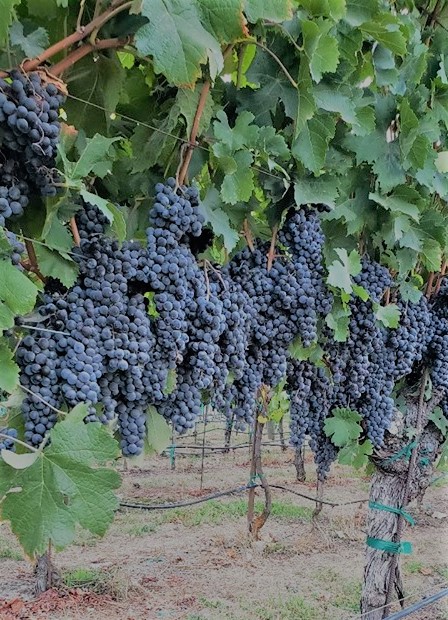The Santa Ana winds are whipping across California.
The dry, warm, harsh winds pose a real fire hazard thanks to all the dry vegetation.
I've spent much of the last few weeks in Napa working the "crush." It's one of my favorite times of year.

Merlot grapes ready for picking
Harvested grapes come into wineries and are pressed (or crushed) on a crush pad.
But thanks in part to the Santa Ana winds and the dry weather, this year's crush is a little extra stressful due to planned power shutoffs.
Our power provider Pacific Gas and Electric ("PG&E") decided that to reduce wildfire risk, it would shut off power for hundreds of thousands of folks across Northern California. We've lost power for days at a time while PG&E inspects lines for fire hazards.
The outages haven't dampened anyone's spirits out here in Napa as we pick and crush grapes. But it does remind me that you should always be prepared for these types of emergencies. If you're not ready, several days without power is stressful and possibly dangerous.
So here are two simple tips that could save your life during an outage...
Keep enough distilled water to last for at least one week. You'll need a liter per person per day, at minimum. And when there's a crisis that can cause power outages, I fill up my freezer with water containers. A full freezer keeps frozen food cold for 48 hours, twice as long as a half-full freezer.
Always keep extra non-perishable food in your house. I recently purchased a case of 32 freeze-dried meals. They just need a little water before they're ready to eat. My only worry is what wine to pair with them (cheap reds, I think). I also rotate approximately 50 cans of soup and beans in my cupboard.
If you want to keep up with my wine adventures, make sure to follow Eifrig Cellars on Facebook, Twitter, and Instagram.
How do you prepare for emergencies? Send us your tips... feedback@healthandwealthbulletin.com.
Q: From your essay of today's date: What about drinking water that has gone through a water filtration system that uses activated charcoal? – B.H.
A: Charcoal filters are common for water. That's because, as we mentioned last week, charcoal is good at "sticking" to things you don't want to ingest. When you use a carbon filter, some of the particles will get into your water – just not enough to do any harm. If you are worried, just make sure to run the filter under water or soak it for a few minutes before using it. That'll help get rid of the smaller particles.
Q: On a recent visit to my GI doctor, my blood pressure reading was 130/80. I was told that that's considered higher than normal. My blood pressure in the past has always been "within normal limits." Is this cause for concern? Some research I've done tells me that high was once considered anything above 140/90. I trying to not freak out here. – A.C.
A: Don't freak out quite yet...
In November 2017, the American College of Cardiology, along with the American Heart Association, changed the diagnostic criteria for high blood pressure, or hypertension.
"Normal" blood pressure is 120/80 mm Hg. And, two years ago, anything reading 140/90 mm Hg or higher meant a diagnosis of hypertension.
But the new limit is now 130/80... meaning an additional 31 million Americans qualified as high blood pressure patients overnight.
(It's important to note that several members of the scientific panel had direct financial ties to pharma companies that make blood-pressure drugs. Worse, they neglected to properly state their ties in the report. That's a huge breach of policy.)
The first thing you want to look at is what were your numbers when you were "within normal limits." Since the limits have changed, you should know if your numbers have changed or if your doctor is using the new limits.
Second, if your blood pressure reading was higher than normal, check it again. There are other factors that could lead to higher than normal blood pressure. Any sort of stress or anxiety can do this do you.
That's why it's important to monitor your blood pressure. You may also want to start testing it at home with your own device or go to your local pharmacy to get a reading. Keeping a log will help you understand which changes to your lifestyle work best if you need to make any changes. You can read more on how to do that here.
Q: Your answer to that recent question [regarding how to account for dividends in stop loss] does not go far enough for me to understand completely. Does one subtract only the most recent dividend received or all of them since original purchase of the stock? – S.C.
A: Yes, you want to include any dividends you receive. Let's take a look back at our example...
If you're buying a stock for $10 and set a 25% trailing stop, you would sell the stock when the price falls 25% lower than $10 (down to $7.50). If the price moves to $20, your new stop would be $15.
Let's say you held the stock for three years and received a $1 dividend payment each year. That means you've received $3 in dividend payments. All you need to do is subtract that total dividend payments of $3 from the highest share price – $20, in this case. Then you use that number – $17 ($20 minus $3) – to set your stop loss. So your stop would move from $15 to $12.58 ($17 times 75%).
Keep sending us your questions, comments, and suggestions... feedback@healthandwealthbulletin.com.
What We're Reading...
- Did you miss it? We're winning the fight against cancer.
- Something different: The art of matpakke.
Here's to our health, wealth, and a great retirement,
Dr. David Eifrig and the Health & Wealth Bulletin Research Team
October 18, 2019
